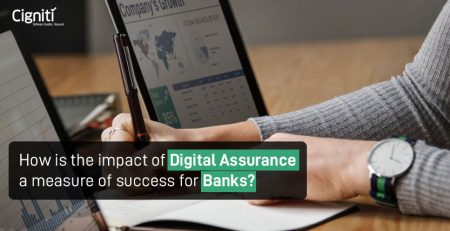CIOs in the driver’s seat – Driving Digital Transformation in Banks
|
Listen on the go!
|
A long-distance car ride needs a lot of prepping up before you even hit the road. Getting your fuel tanks filled up, checking the tires for tread and pressures, a look at the map from the starting point to the destination, maybe even identifying spots for refueling, making reservations for a stay and checking few other financial aspects. Once you hit the road, you make sure there are minimal deviations to the plan to enjoy a smooth and event-free ride. Technology and digital transformations for banking sector require a similar thorough planning with an effective mix of Digital Assurance and Software Testing.
Banks undergoing digital transformation of their core banking systems face a huge risk of failure. There have been situations when the project becomes a shelfware once the initial round of funding is successfully secured. Such programs get overrun, years beyond the due date along with misaligned expectations and in some cases, leading to career failures. CIOs invest significant amount of time, effort and money to vet their software vendors, and system integration partners. However, successful banking transformations require more than just that.
The maturity and sustainability of the transformation project is contributed by several critical factors including sustained buy-in and sponsorship from the leadership, understanding the skill gaps, and identifying and mitigating program risks, internal work culture management, persistence and perseverance, and more.
Here are a few recommendations that can guide a CIO’s journey to technology transformation.
Relevant and calculated Software Testing and QA strategy
Incorporating a digital strategy is a conscious decision, but ensuring that this strategy fits into the overall organizational game plan is absolutely business critical. Digital Assurance and Testing enables teams to ensure seamless interaction within the digital ecosystem – individuals, procedures, and Social mobile, analytics and cloud (SMAC) stack. These digital assurance practices help organizations to deal with all kinds of internal and external complexities occurring due to sudden strategic decisions. As estimated in a report the Global Digital Assurance Market accounted for USD 2.81 billion in 2017 and is projected to grow at a CAGR of 14.1% the forecast period of 2018 to 2025.
Sustained business sponsorship and ownership
Given the enormous impact it would have on the bank’s customers, stakeholders, employees and shareholders, such transformation projects need a leader who is in charge – one with ultimate accountability and authority. This person must be able to steer the entire project, gain buy-in from the stakeholders, commit resources for the effort, communicate and give the project required visibility within the shareholders, lest it becomes just another “IT project”.
The role requires one to go beyond the usual kick off meetings and chalk out the overall strategy structure of the program with milestones identified clearly for the upcoming program phase and deliverables (based on the past and current strategies), and highlight relevant progress based on key performance indicators.
Gathering skill sets and experience needed for the program
Large banking programs abound with complexity and risk. When banks set out to achieve the program goals, they may not have the required skills, capabilities and experience much needed to achieve the end goal.
Robert Alexander, CIO at Capital One, has been working towards technology transformation of the 30 years old company largely known for credit cards. “Attracting the right talent with the right tools and technologies is a part of our cloud program, and Capital One has worked over the last several years to change its mix of technology talent.” In 2011 the company had 2,500 people in IT and 40% of them were in engineering job families. He added, “Very few were developing software. Now the group is made up of 9,000 professionals, and 85% are in engineering job families”, according to Alexander. “The talent transformation is probably the lynchpin.” he said in an interview to Information Week.
CIOs can also delegate program leadership of project management to other software vendors of system integrators. It is indeed a make or break event in a career for most of the banking team. It is hence important to identify the resources with technical knowhow, project management skills as well as communication skills. Pick only the “best resources” for the program. Settling for second best resources can translate into magnified costs at a later stage. Such programs seldom have scope for fixing errors. CIOs can also opt for embedding internal project managers to ensure knowledge transfer to ensure minimal long-term dependence on the vendor. Such resources can also ensure that the bank’s interests are served as the program progresses.
Program Governance and decision making
It is important to have program governance clearly defined to give enough space for voices and answerability for actions. The person with the final say also needs to be clearly identified in case of any contentions amongst the stakeholders over priorities, approach and scope of the program. Absence of such a governance structure will lead to delays, overruns and program fatigue.
Managing the resistance from internal culture
“If you focus purely on digital and forget the organizational change you have to make, you won’t get very far.” said DBS Bank Chief Information Officer David Gledhill while sharing his insights on DBS’ digital transformation with McKinsey
The organization needs to be tuned in to the transition as well since digital transformation requires persistent aggression to help the bank sustain the impact of the change. The entire organization should be informed about the program, its objectives, and expected outcomes. This exercise is crucial as the employees and stakeholders will be engaged in the program and will eventually be trained on the new business processes. The success of a digital transformation journey is grounded in the organization’s culture. An organization open and ready for transformation has higher probability to successfully transition into the new ecosystem.
The CIOs need to slow down before initiating the program and assess the internal readiness of the banking organization for such transformations. Such transformations require greater innovation, collaboration and technological convergence. That said, IT can’t own digital transformation by themselves. The rest of the business needs to have skin in the game also. It is definitely a ‘team sport’!
Conclusion
Even with all the challenges that need to be overcome, the Retail Banking sector is an interesting and exciting space, and it gets much more intriguing when a start-up bank shares its growth story.
Join Cigniti Technologies on Thursday, March 14, 2019 at WeWork, 1 Fore St Ave, London for an interesting QA meetup and an interactive session with Dono Greeff, Head of QA ClearBank®, as he takes us through his successful QA journey at ClearBank, sharing key insights on how QA helped transform the journey of the #bank and scale up over the years.
Come along and meet up with your peers and experts in the industry.
Click here to know more: https://bit.ly/2IJK3xz





Leave a Reply